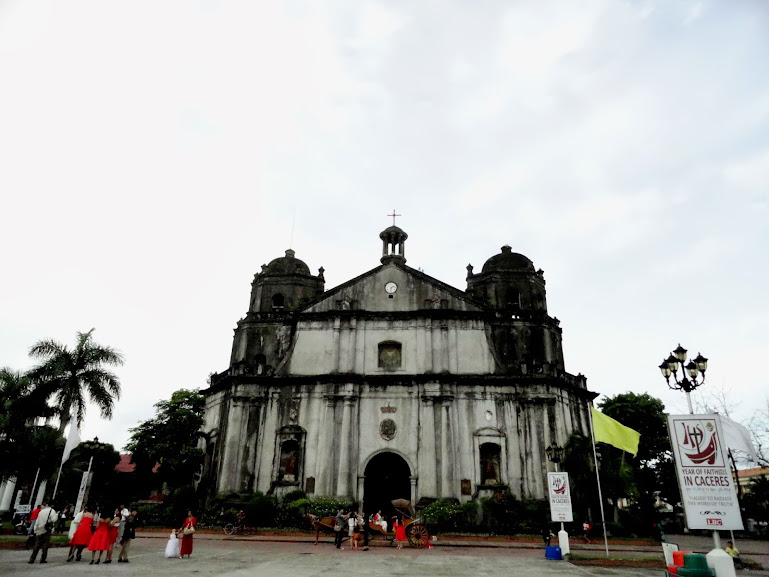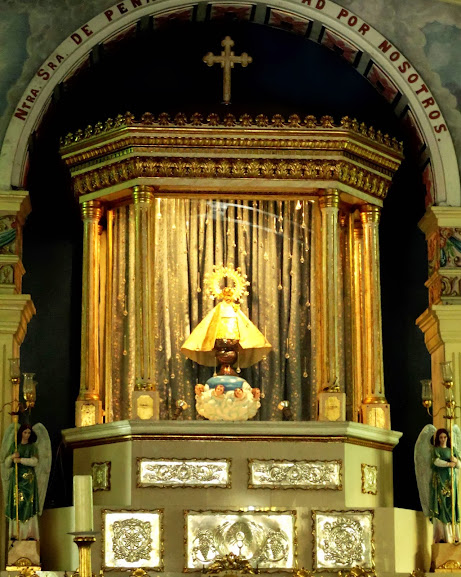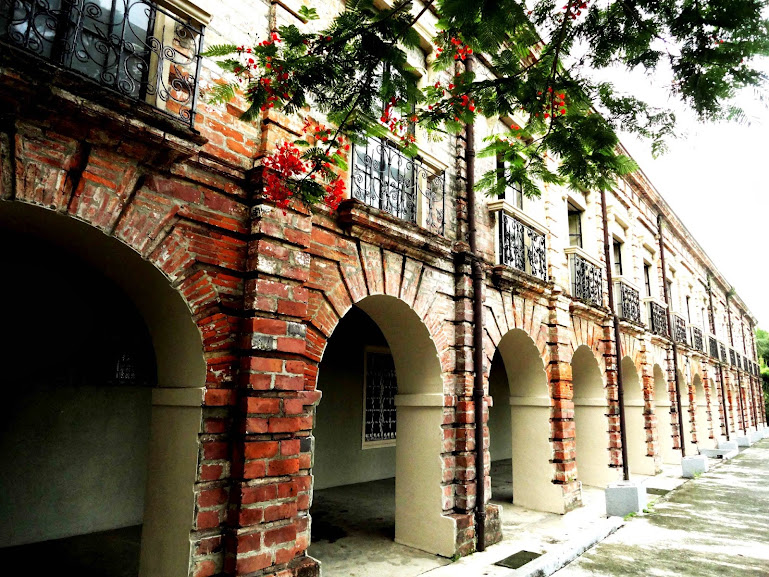A visit to Naga is not complete without seeing our Lady of Peñafrancia. There’s no crowd this time of the year, if you want to see one, visit Naga on the 3rd Saturday of September—some say the people that gather for the Lady’s feast is around 5-6 million!
Now that’s a crowd.
Viva La Virgen!
The origins of the church and icon was born inside the mind of a scion of the well-to-do Covarrubias family from Cavite. The young Covarrubia, a seminarian from Manila, committed to build a church in honor of the Virgen de la Peña de Francia after being cured from an illness in Manila. Virgen de la Peña de Francia is an iconic 15th century image of our Lady in the university town of Salamanca, Spain. Covarrubia plan was to built the chapel near the bank of Pasig river.

This is the old site where Covarrubias had his chapel built. What we see today is the church Bishop Arevalo built in 1753. The original image of Peñafrancia and the ‘divino nostro’, an easel painting of Christ’s face has been transferred to the modern Basilica Minore.
How it ended up in Naga?
Padre Miguel Covarrubia was sent to Nueva Cáceres (now Naga) right after he was ordained. Since such assignments takes up years, this Dominican priest foresaw that he could not build the chapel in Manila, so he had it built along the Bicol river. He then commissioned an artisan to work on making a replica of the Virgen de la Peña de Francia. And the rest is history.
The image of Our Lady of Peñafrancia is unique because unlike other sculptures made of exorbitant materials it was simply modeled out of wood. The original image of Peñafrancia and the ‘divino nostro’, an easel painting of Christ’s face has been transferred to the modern Basilica Minore in barrio Balatas.
I wonder if the Covarrubia’s still have relatives left in Cavite. I know someone with this last name but he claims that his family was originally from Zamboanga. That makes sense because Cavite and Zambaonga are linked because both are major ports during the Spanish era. Both coastal towns eventually developed their ‘chabacano’ from regular contacts the people made with Spanish tripolantes.
Traslación
As narrated by a man I met in the Cathedral who was waiting for his daughter on his tricycle. The procession starts in the church of Peñafrancia, carried by barefooted men to the Cathedral, it passes the major thoroughfares of the city. They call these men ‘voyadores’. These procession last anywhere between 2 to 3 hours. Then there’s the fluvial parade where he said foreigners and women are not allowed to embark on the water pagoda carrying the Peñafrancia. I asked why? Manong Ed’s response was that it’s going to be a “bad year” when that happens.
In the 80’s, believe it or not, the image of Peñafrancia was stolen. It was gone for a year before it was surrendered to a bishop. A few law enforcement died trying to retrieve it. I could not understand why someone would steal this icon (locals affectionately calls “Ina”), other than its value as antique, it’s entirely made of wood. Those crooks probably planned to sell the icon. Just imagine the celebration when the image was returned. People were out in the streets celebrating while a typhoon rages.
The Cathedral and the seminario del santísima rosario

The Cathedral with a calesa in front of its door. There was a wedding pictorial and I think I bombed some of those takes!
I was excited to see this imposing building along with its old seminary. Reputedly one of the most beautiful seminary in the region. I was relieve to see that they’ve at least retained the appearance of the seminary. The red brick structure with those perfect cloisters was so charming. It’s among the best preserved Spanish era structure I’ve seen in the province. This seminary started as ‘casa de clerigos’, literally a house for the priests. Then it became a seminary in the last 18th century, ‘seminario conciliar de nueva cáceres’. It was renamed ‘seminario del santísima rosario’ under the Vincentians. In 1964 under the local diocese decided to do away with the Spanish name and named it, ‘Seminary of the the Holy Rosary’. Some of the most active revolutionaries in the late 19th century attended this school. Which made me wonder what kind of classes they used they taught here!
The time I was walking around there was this lovely carriage ornamented with flowers and ribbons that carried a bride and his groom. Now, that’s something you don’t normally see in Manila.
Now, going back to the Cathedral, in the 80’s renovation work was started to give the church a face lift. This ended in 1988 and there was a big celebration attended by the church hierarchy and local priests from around the region. Looking around I could see that the restoration had covered the original surface of the church with concrete. Then the interior was completely painted over and the designs were nice. I found nothing out of place. I believe the move was more practical and economical but I’d prefer a restoration that conserves not only the look but the original material used. The trouble with cement is that overtime it hardens and becomes less porous. Such practice has cause a lot more trouble for some of the older churches because eventually the covered portions becomes weaker from the trapped moisture. I could be wrong with my observation here, I speak from experience and not from someone that had classical training on the subject.
If there’s one thing that I appreciate with the restoration of the Cathedral was that its appearance remained as it was when the Franciscan Bishop de la Concepcion had it built in 1800’s. The Spanish-Romanesque style and its dominant presence, wide facade and towering bell towers remains a sight to behold to this day. Talk about an imposing building—this is one, I could just imagine how it dominated the skyline back in the day.
These churches are great examples of architectural designs evolving with environmental dynamics. The design and construction was conceptualized with the regular typhoons that visits the province in mind. This is a fascinating aspect of Philippine churches and houses.
Filipino Architecture as Filipino
I remember an architect who works for an American contractor who wrote to me and insisted that Spanish era structures are not Philippine but ‘colonial’, or must be called as such. I then asked what’s Philippine then? To this the response was “everything that carries no influence of Spanish, like those coastal houses on stilts…” I no longer responded, we both agreed to disagree.

Escudo in Nueva Caceres Cathedral. Escudo pequeño del Rey de España con las Columnas de Hércules. Apareció durante el reinado de Felipe V y fue usado hasta 1868. Este formato de escudo fue el origen del actual.
When I was in Singapore I visited Malaysia on several occasions. And there I saw those same coastal houses on stilts. Those folks are certainly not Filipinos. If I follow that commenter’s logic then those Malaysian fishing villages are more Filipino than most of us. They had no trace of foreign influence other than their religion which encompasses everything in their lives.
This is where I feel most of these intelligent people miss the point, they see history as static when it’s not. What they refuse to accept is that it was the reaction to the changes that’s genuinely Filipino, not the inaction.
The thing is that we’ve been taught that you become more Filipino the farther you get away from our hispano-filipino past—so everything that has some relation to it is dismissed as colonial, therefore, must be excluded. This confuses our students because they’re taught to be proud of their town’s old churches and those hispano-filipino houses but in the same breath instructed that era was nothing more than an interlude, an interruption in our evolution as Filipinos.
—
May 2013






